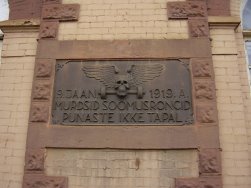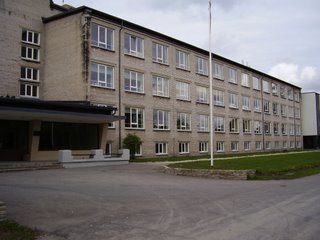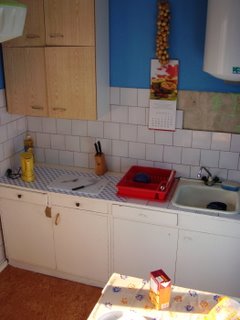


These are some of the cool graphics on ETV and on their web site. ETV (i.e., Estonian Television) is pretty close to PBS in America, at least in terms of programming.
Now, before the nightly news at 5 p.m. and 6 p.m., they promote Teatriaasta 2006, the year-long celebration of 100 years of Estonian theatre, with lively advertisements for upcoming concerts and performances. They sure beat getting brochures every week from the Goodman, Steppenwolf, and the Lyric Opera.
24 September 2006

On September 21, 1944, as German forces left Tallinn, Estonia’s national flag was raised on Pikk Hermann Tower, the seat of the Estonian government. On September 22, the next day, Soviet troops conquered Tallinn. The country’s national tricolour was torn from the mast on the tower and was replaced by the red banner, the symbol of the new occupation. By the end of November, all of Estonia was again under Soviet control.
Estonia and the other occupied Baltic states were the only countries who had been overrun during the course of World War II but whose independence was not restored at the end of the war. Moreover, Estonia and the Baltic states were the only members of the League of Nations who were not given seats in the new United Nations.
Read more in The White Book, compiled by a special commission of the Estonian parliament.
23 September 2006
Another reason I love this country: the Alma milk is from Estonia and the Amigo juice is from Spain. No, it's not. That would make too much sense. I think the juice is from the Ukraine.
Cuba, the "revolutionary light" beer is definitely Estonian. Here, they are not afraid of Cuba. You can fly the 5,500 miles from Tallinn to Havana for less than $2,000.
19 September 2006

September 1 is the traditional first day of school in Estonia. After the official welcome, all of the students, except the first and twelfth graders, go to their homerooms. In a nice ceremony in the auditorium, the twelfth graders (each wearing their school cap, or tekkel) welcome the first graders by giving them school caps, too. So I think every student in Estonia has a school tekkel.
Tapa Gümnaasium is an elementary, middle, and high school. So this September 1 ceremony is filled with the symbolism of first/last and youngest/oldest as well as of the beginning of a journey - through childhood and adolescence and into adulthood.

Tapa Gümnaasium, where I teach English to 8th, 9th, 10th, 11th, and 12th graders.
18 September 2006

My apartment building and my front door.
I'm on the fifth floor, and the third and fourth windows (not counting the stairwell windows)from the left are my kitchen and bedroom windows, respectively, in case you wanted to drop in from the roof.
I live on Lembitu Street, and Kreutzwalk wrote a poem about Lembitu, who lived so long ago he has only one name.

Tere tulemast Eestimaale.
Here, somewhat fittingly, I think, Friedrich Reinhold Kreutzwald, the author of the first original Estonian book and the father of Estonia's national literature, welcomes me to Estonia.







